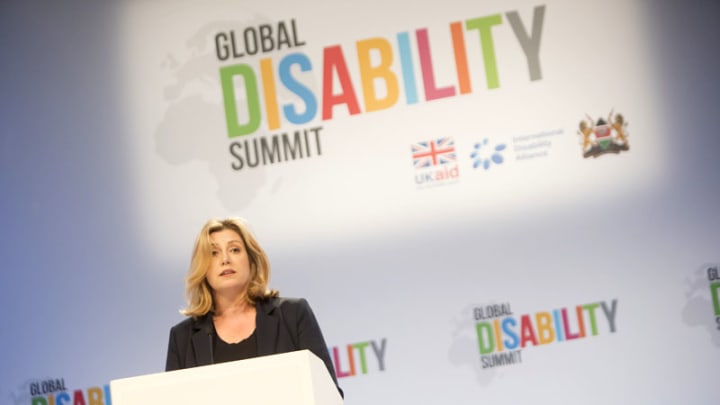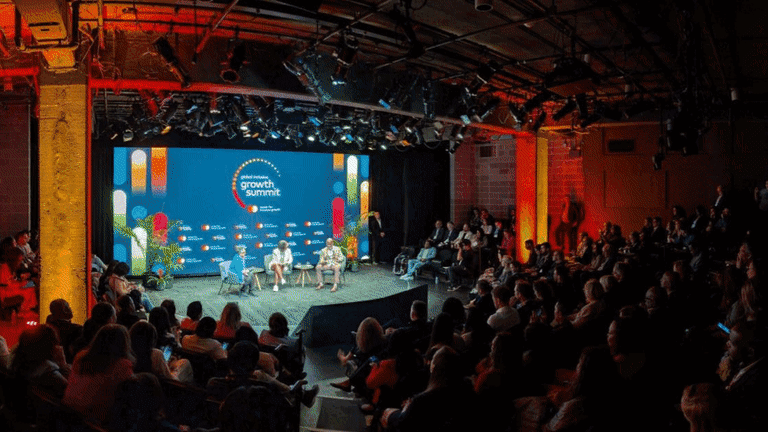
LONDON — Tuesday’s Global Disability Summit in London yielded 170 commitments to increase disability inclusion and tackle stigma in lower-income countries, according to the United Kingdom government, from financial pledges, to in-kind devices and technology, to new or amended action plans and charters. But some worried that parts of the disability community were left out, while others described a disconnect between large humanitarian agencies and specialist disability-focused organizations.
Hosted by the U.K. Department for International Development, the Kenyan government and the International Disability Alliance, the summit marked the first time the humanitarian and development sectors have come together formally to plan action on making aid more inclusive of people with disabilities. More than 800 delegates from government, civil society, and the private sector attended to discuss four themes: Addressing stigma; supporting inclusive education; economic empowerment; and technology and providing better access to devices.
Global Disability Summit targets faster progress on inclusive development
More than 800 delegates from government and civil society are convening in London yesterday for the first Global Disability Summit — a chance to ask why so little progress has been made toward disability inclusion in development initiatives.
“We have a good example of what works: We’ve been doing this for many years on gender, and we’re applying the same principles to disability,” Penny Mordaunt, secretary of state for international development, told Devex on the sidelines of the event.
“Later this year, we’re going to be announcing a more structured framework as to how we take this forward with all of our work and all of our funding,” she said, adding “it’s about having that framework so it’s absolutely embedded in everything we do, just like we did with women and girls.”
On top of the new framework and other commitments, DFID also launched the Charter for Change, an action plan for implementing the United Nations Convention on the Rights of Persons with Disabilities, which was signed in 2006 but only saw renewed enthusiasm from donors a decade later.
“One of the biggest challenges is that there are very few role models, very few good [practices] for people to learn from, and you have to have people with disabilities actually in the spotlight to actually demonstrate the capacities, the decision making, the lived experience,” Kirsty Smith, chief executive of disability charity CBM UK, told Devex. “While they aren’t there, you can continue to think of people with disabilities as ‘the other,’ and I think that’s where they have stayed.”
Smith also emphasized that people with disabilities who have been “excluded from education, decision making” have also “not recognized their own rights, and therefore have been slow to claim them,” resulting in a “legacy of exclusion.”
She added that compounding matters is the fact that “development actors think in silos: ‘Let’s do environment this decade, then we’ll do gender,’ and unfortunately funding follows priority.”
Though the summit was not billed as a pledging conference, the main financial commitments included $17 million from the Australian government to support disability inclusive action in response to the Syria crisis; and a pledge from the UN Trust Fund to End Violence Against Women to spend $3 million on nine programs that will reach 8,000 women and girls.
The World Bank pledged to ensure that all bank-financed education and urban mobility projects are disability inclusive by 2025, and to scale up the collection and use of disability data. The United Nations Children Fund has pledged to help an additional 30 million children with disabilities gain a high-quality education by 2030 through programs in more than 140 countries; and UN Women has committed to including a focus on women and girls with disabilities in 80 percent of its country programs by 2021.
Asked about UNICEF’s immediate next steps following the commitment, Executive Director Henrietta Fore told Devex that UNICEF and other aid actors must look at a child’s environment, rather than their disability, in order to enable change.
“Part of our mission at UNICEF is to make sure there’s inclusive education, so with half of these children [with disabilities] out of school, our number one mission should be to get the children in school and to have good teachers and an inclusive environment where we begin to change the culture,” she said.
“They may need an assistive technology, they may need a good teacher, they may need parents and community that accepts them and realizes how much they can contribute. We need to see them as children first and children with disabilities second.”
Primrose Mandishona, a disability activist in Zimbabwe and a founding member of CAMA, agreed but added that not enough has been done to move inclusive spaces from the rehabilitation clinic or international conference to the home and community.
“Sometimes children are being hidden. You go into the village, there are probably three children with cerebral palsy, but only one is known, the other ones are behind closed doors. We work with schools and community to actually identify children with disabilities who are sometimes not known,” she told Devex.
Mandishona said her goal as a rehabilitation technician is to “promote independence, it means social, economic independence,” and added that often conducting rehabilitation sessions in a clinic “is not enough. We go to the homes, you do home assessments to see the environment, see if it’s fit, then construct what we need with local resources, to establish continuity. Often when they leave the hospital, they go home and that continuity is broken because they have to wait to go back, which is sometimes a long time if they live in a rural area.”
Nine African governments committed at the summit to “creating safety nets to ensure that people with disabilities are not forgotten about in their societies,” according to a statement from DFID. Nineteen governments, businesses and other organizations also pledged to develop the skills of people with disabilities to help them access decent work.
Still, a number of delegates said that pledges were so far missing something or, in Mandishona’s case, missing someone.
“I feel that there’s many of us being left out — those in the psychosocial support area. We really need to involve people at grassroots level [living with] psychosocial support, the family and the local leaders,” she said.
Some pointed to the issue of disability inclusion in humanitarian settings. Naser Haghamed, chief executive officer of Islamic Relief, told Devex on the sidelines of the summit that “the funding infrastructure of humanitarian programs is short term; it doesn’t allow you to design and implement inclusive programs.”
As violence escalates in Syria, new data on disabled children caught in the crossfire
Three hospitals near the Syrian city of Daraa were shut down by airstrikes last month, as new data about the number and living conditions of children with disabilities in Syria paints a stark picture.
“As an example in education, if you’re responding to Syrian refugees in Jordan, how will you integrate them and make inclusive programs with the schools, when the schools do not have the physical facilities, the teacher training, the materials? That takes a long time, and by that time your funding is over for humanitarian programs.”
Haghamed also suggested that “the mainstream organizations are not participating fully in terms of engagement.” While many of the larger recipients of donor financing sent individual delegates, “they are not there” in terms of commitments, he said. This disconnect with grassroots and specialist organizations is hurting the effort to mainstream disability in development and humanitarian initiatives.
“As both a mainstream organization and a faith-based organization, we have access to millions of people working in 40 countries, but we need to work more with DPOs [disabled persons organizations], with technology companies on disability, and that is not happening. Can DPOs do it on their own? Many DPOs do not go into humanitarian situations in those remote areas, but they still have a certain skill set that we need, but if we are not here then I don’t know how it’s going to work.”




